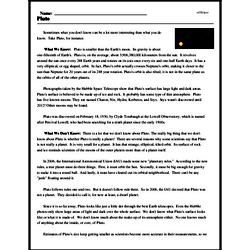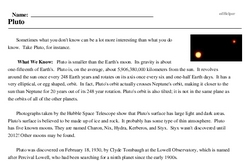Pluto
The Discovery of Pluto
Reading Comprehension for February 18
Sometimes what you don't know can be a lot more interesting than what you do know. Take Pluto, for instance.
What We Know: Pluto is smaller than the Earth's moon. Its gravity is about one-fifteenth of Earth's. Pluto is, on the average, about 5,906,380,000 kilometers from the sun. It revolves around the sun once every 248 Earth years and rotates on its axis once every six and one-half Earth days. It has a very elliptical, or egg shaped, orbit. In fact, Pluto's orbit actually crosses Neptune's orbit, making it closer to the sun than Neptune for 20 years out of its 248 year rotation. Pluto's orbit is also tilted; it is not in the same plane as the orbits of all of the other planets.
Photographs taken by the Hubble Space Telescope show that Pluto's surface has large light and dark areas. Pluto's surface is believed to be made up of ice and rock. It probably has some type of thin atmosphere. Pluto has five known moons. They are named Charon, Nix, Hydra, Kerberos, and Styx. Styx wasn't discovered until 2012! Other moons may be found.
Pluto was discovered on February 18, 1930, by Clyde Tombaugh at the Lowell Observatory, which is named after Percival Lowell, who had been searching for a ninth planet since the early 1900s.



